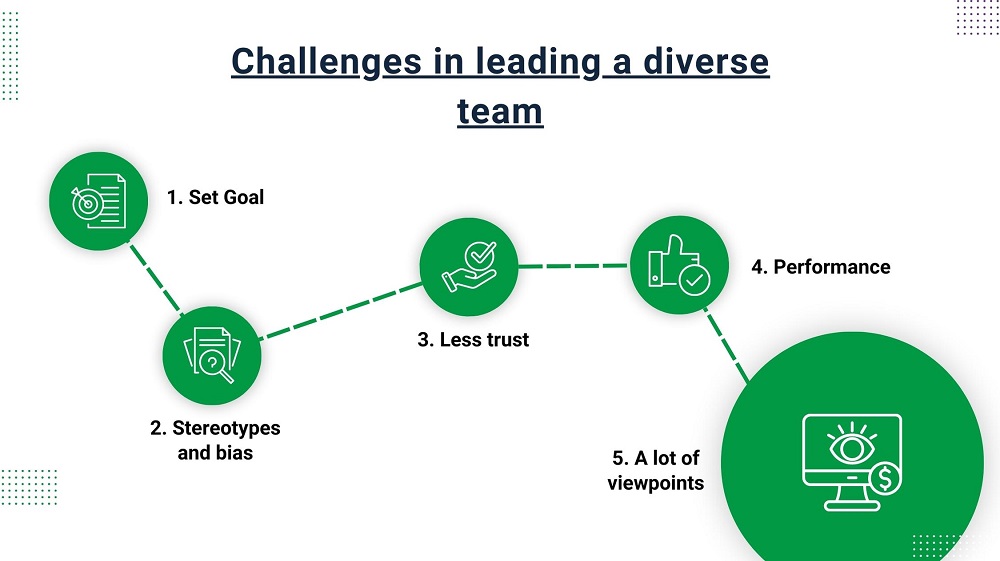A diverse team is referred to as the difference of the individuals based on culture, language, ethnicity, age, skills, and overall perspective. Having a diverse team in your office is a positive thing, since it offers you various skill sets, innovation, and creativity. However, leading a diverse team is not an easy job.
Because in order to manage team members, you need to have cultural and background understanding. Most importantly, you need to communicate and ensure every person on your team feels valued.
So, in this post, I will share complete information on steps for leading a diverse team, its challenges, and how you can build your very own team.
Why is it important to have a diverse team in 2023?
Nowadays, having diverse individuals working together in companies is quite common since they’re very well-versed in different kinds of skills, creative ideas, and innovative ways to tackle problems.
Also, for managers and leaders, diversity is important, and this is because it provides an extra pool of skills with the ability to understand the customer’s demands or requirements.
Moreover, individuals from various backgrounds provide you with an edge to collaborate on the global level.
With diversity, you can get:
👉 Boost team morale
👉 Enhance problem-solving and decision-making
👉 Improve the retention rate
Challenges in leading a diverse team

Different groups in the working environment are favorable due to their particular abilities, skills, and perspective. Even so, various issues could weaken work process proficiency and group agreement while working with diverse teams.
I’ve incorporated probably the most well-known issues that managers experience while managing diverse team members:
1. Communications barriers
The first and foremost challenge that comes with forming a diverse team is language. Since people may be from different cultures and traditions their language would be different and it would be tough for the team to communicate. Consequently, this communication barrier leads to misunderstanding, confusion, and lack of collaboration among team members.
2. Stereotypes and bias
In workplaces, stereotypes, and biases really do happen, which can affect the cooperation among team members. These stereotypes can be based on ethnicity, nationality, and caste. When individuals hold such biases, this could result in a lack of trust and reduce employee communication. Moreover, when an individual in an organization deals with such concerns, it demoralizes them and lowers their job satisfaction.
3. Less trust
Team members need to trust each other. But, since members are from different backgrounds, communication is limited, which prevents relationships from building. Consequently, when team members don’t build friendly relations, they do not trust each other, leading to communication breakdown and a lack of mutual support.
4. Performance
Conflict is unhealthy in the workplace and can considerably reduce employees’ performance and morale. Diverse groups can result in the long-term success of organizations. However, if disputes arise from culture differences, it would lead to enduring unfavorable effects on employee fulfillment, the business’s credibility, and its image, and a lot more.
Read more: Strategies for Maintaining Work-Life Balance in the Workplace
5. A lot of viewpoints
With their various backgrounds and experiences, team members have various methods of approaching the same situation and putting forth their suggestions. Team members who do so are extremely important to your organization; they will keep driving innovative suggestions and determining issues.
However, too many points of view can compromise the organization’s capability to stay with limited due dates which reduces efficiency and productivity.
Although it is difficult to manage a multicultural setting efficiently, there are some valuable steps you can take to improve your organization’s workflow with diversity.
Steps to leading diverse teams effectively

Based on my experience, below I am sharing some key strategies that will help you tackle the challenges of diverse teams:
1. Gain self-awareness also assess your biases:
Taking care of a diverse group starts with obtaining a far better understanding of yourself and knowing your biases. Keep in mind that nobody is immune from having bias.
However, the important point here is to remove those biases that might cause trouble to others and are hampering others’ ability to work. You can learn from the opportunities conveniently available from your business to reconsider and strengthen what you’ve believed. As a result, you’ll be able to help your team members to follow the same.
2. Know that diversity is not what you see
Often, diversity is visible, however, only a few times. Points that make individuals diverse may be unseen, such as sexual orientations, religions, physical conditions, psychological wellness, and specific disability. The method around this is to familiarize and be conscious of everyone’s special identity.
Gain a better understanding of what each specific employee needs to do well and intend to give any required accommodation whenever feasible. Bear in mind that as a leader, you are an important person in your organization, and you are also the most powerful supporter for your team members.
3. Think about managing diverse thinking of the team
The stats noted in the above part of the article provide value of diversity, but let’s look at the factors behind them. When you have a diverse team, you benefit from various perspectives. Yes, this can be testing to manage, but it’s valuable. That’s because various perspectives can improve discussions, put faulty procedures into the witness box, increase new levels of thinking, and prompt developments.
Your task as a manager is to harness the power of diverse thinking and channel it to craft cutting-edge remedies and create new opportunities for your organization.
4. Develop your skills as an understanding leader
Research shows that compassion is one of the most crucial management skills a manager can have. It’s additionally essential for taking care of diverse teams. Today’s team members want their job to complement their life. To enable that to occur, develop a safe room for employees to rely on you to ensure that you are familiar with what’s helping them and what’s not. Maintain a continuous pulse on your employee and consider their concerns as:
✔️ Do they feel consistent in the group and the company?
✔️ Do they require additional information for their work?
✔️ Are they stressing about the task, and if so, what can you do to assist?
Utilize what you discover to engage and secure them, as they are your organization’s most valuable resource.
5. Learn about diversity management techniques
There are specific methods of diversity management that need education and learning. It’s easy to state that you want to be much more inclusive, but you, as a manager, have a special collection of needs requiring ways, tools, and guidance. Such education both via the company and your research study can assist you in recognizing when you require to interfere in a circumstance, what adjustments you may require to make to your very own behavior, and how to grow a diverse atmosphere where everyone can thrive.
To successfully take care of diverse teams, you must be skilled in inclusive management practices, such as recruiting and hiring, assisting in team conferences, dealing with conflicts, reviewing candidates, and producing fairways of advancement.
6. Give employees leadership development opportunities
As part of your purpose to appreciate and take advantage of the unique background and culture of your employees, save some time to better understand your employee’s goals. This will allow you to work with every person on their occupation track. As you do that, assess where there may be chances in your company for an employee to handle a management duty. Take into consideration cross-functional team possibilities around certain job roles. Offering team members the possibility to handle new job roles will help them (and you) to better recognize their skills and weaknesses.
7. Be an active listener and look for feedback
Handling diverse groups means creating an environment where people gain from each other, and each person is listened to. All point of view rate and cooperation is enhanced by canvassing different concepts and strategies. Ultimately, managing a diverse team is effective when managers are open to receiving responses and actively seeking them out. The best mix is to do this both informally and formally.
Skills to develop when managing diverse teams
Being a leader, you need to develop various skill sets that can help you lead diverse teams. Below I have shared a list of skills that must be on your learning priority.
➡️ Empathy: Empathizing with the team members helps you and your employee solve a problem singularly. More importantly, it enables you to create an environment where employees feel motivated to thrive and be productive.
➡️ Good cultural intelligence: To be a good leader it is important for you to be well aware of your staff culture. You can do this by reading or by learning directly from your employees.
➡️ Emotional intelligence and self-awareness: These combination of skills allows you to have social interaction, build relationships, manage your emotion, and make more thoughtful decisions.
➡️ Good communication: With good communication, you can manage teams effectively by assigning goals, knowing their desire, and solving their problems. Moreover, good communication can help leaders have harmonious relationships with employees.
➡️ Get creative with check-ins: Frequent one-on-one check-ins have been shown to be a successful method for keeping your staff informed and engaged.
➡️ Get social: Social communication can foster better communication and trust. So, connecting work with higher-value social communication greatly benefits, and you should use it.
➡️ Acknowledge generational differences: You need to connect your team members by clearing the generation gaps. Since, each generation of individuals, has a different idea, you will have a variety of ideas for your project.
How do you build a diverse team?
Building a diverse team is a lengthy process. That requires several steps to follow. To assist you in building a successful diverse group in the next section I will provide you with a handful of helpful tips.
✅ Hire individuals from different backgrounds
As a first step you need to start hiring people from different backgrounds. You can consider. But it is important to consider that you hire people that are relevant to your business. As a result, you can ensure that you have an employee base of strong skills and experience.
Read more: Hiring The Right Talent: All Aspects Covered
✅ Allow open discussion
Through open discussion, you will provide your employee a chance to share their views, perspective, and ideas. Moreover, it will help you understand their behavior, skills, culture and how with their experiences they can help solve problems related to your business. To have these kinds of open discussions you can arrange special sessions during the working hours of your employees where they can share their thoughts freely and frankly.
✅ Personalize company culture
Making your company culture personalized is one of the effective strategies that will help you retain your employees. The reason behind this is simple: when you make the office culture according to employee liking, personal needs, and general requirements, they genuinely feel good and stay longer with the company. But to personalize your work culture, you need to know the requirements of your employees, so you can come up with a perfect solution.
✅ Make employees feel valued
When employees feel valued, they feel happier and more productive. There are many ways through which you make your employees feel valued few of these are:
- Provide awards and recognition for their hard work.
- Offer growth opportunities for experienced employees.
- Conduct sessions for employees’ well-being.
- Offer flexibility to work at different times.
- Considering employees’ feedback, views, and ideas.
Read more: How to Create a Safe Space at Work?
✅ Identify and eliminate biases
Biases in the work culture can lead to workplace bullying, unlawful harassment, and discrimination, which can put your business at risk. Therefore it is essential for you to identify and eliminate biases. You can do this by:
- Monitoring the behavior of your employee
- Creating rules and regulations for biases
- Encouraging employees to speak openly
Read more: How to Deal with Work Stress and Anxiety
✅ Listen your employees
Listening to your employees’ varied viewpoints and suggestions gives you wider insight, so you can make better decisions in your business. Moreover, when the employee’s thoughts are listened to by managers, it increases their productivity and job satisfaction.
Conclusion
Having a diverse staff at your organization can be difficult. At such times you need to create one step at a time process. You can educate yourself and other leaders about the advantages of diverse teams. From there, you can develop and share the guidelines ensuring an environment that is welcoming to individuals from different backgrounds.
This way, you will be able to empower your business with your employees from various ethnicities and cultures.
FAQs about Leading diverse teams
What does it mean to lead a diverse team?
Leading a diverse team means when individuals work together, putting their knowledge and expertise towards the success of their goal by setting aside their cultural differences, age gap, languages, or background.
How can I address conflicts stemming from cultural differences?
To address the conflict due to cultural differences, the most important thing you need to do is to understand their culture. As something that seems appropriate to you may not be good for them. Another way to handle conflict is to communicate clearly with individuals to remove misunderstandings.
How do I ensure all team members feel heard and valued in meetings?
Below are some ways through which you can ensure:
- Create different channels to communicate
- Encourage open and healthy communication
- Conduct a feedback session
- Provide a platform to share opinions
- Reward and recognize employees
What is an example of diversity?
Examples of diversity include when people work from different backgrounds, cultures, languages, gender, race, or ethnicity.
Companies that have diverse work cultures:
- Johnson & Johnson
- Accenture
- Marriott
- Sodexo
- Novartis

















No Comments